This is the first article in the GFF Tube Fly Theme: An introduction to the concept of tube flies and some arguments for using tubes rather than hooks. The article will give you a basic knowledge about tube flies and prepare you for the rest of the theme.
|
|
|
|
|
|
|
|
If we look at the absolute basic setup of a tube fly we have a plain fly pattern tied on a tube. The leader is passed through the tube front to back and tied onto a loose hook, which is then pulled taught to the back of the tube.
Many tube fly anglers extend the tube a bit by using a small, soft sleeve to hold and guide the hook. This sleeve is mounted on the rear part of the tube by pulling it slightly up over the firm tube or just using it as a buffer between the metal and the hook and knot. The hook is then pulled into the soft tube. Others just pull the hook into the stiff plastic tube itself provided there is enough room.
Tubes can also be made from metal, and will then typically be lined with plastic. The tube can be straight or bottle shaped. I will cover all this later in the theme.
Let's first look at some arguments for using tube flies.
Separate hook and fly
It can be an advantage to keep the fly and hook separate for several reasons. First of all you can easily transport a load of flies in a small ziplock bag, and keep the hooks separate in a box, a film canister or even small bags if you like.
The hooks be an assortment of sizes and styles: large and small, singles, doubles and trebles, stainless or not, barbed or debarbed - mixed as you please.
This means that you need to bring fewer hooks and for saltwater anglers it means keeping wet flies away from rust prone hooks, thus avoiding loosing a whole fly every time a hook stains.
You can of course also combine any hook and fly in your assortment, and should a fly be ruined by fishes' teeth, you exchange that and keep the hook, and should a hook become dull due to a snag or hitting a rock, you exchange the hook for a new and sharp one.
No lever effect
When you hook a fish with a tube fly, the hook will mostly work its way loose from the tube and let the fly run freely up and down the tippet. This means that the pull of the line is directly on the short shank hook and not at the end of a long fly. This again means that you have a lower risk of the fish breaking loose due to leverage in comparison with flies tied on long-shafted hooks.
Fishing for toothy fish like pike will add a further advantage to the tube fly setup: the fly will be removed far away from the harmful mouth of your catch.
When you finally need to unhook the fish, you can also grab the hook directly, not harming the fly with your pliers.
Large flies
Some types of fishing call for really large flies. Bluewater fishing for trophies like billfish, tuna, dorados and other pelagic species will typically mean that you have to tie a huge and tasty looking morsel at the end of your line. If you want to tie flies in the sizes needed for this type of fishing on a hook, we're talking a really large hook. Since it also has to be heavy in the wire, you will end up with a very large piece of metal inside your fly.
But tied on a tube, a fly in the 15-25 centimeter or 7-10 inch size, can be a lightweight construction and the hook can be a short shank but still strong hook without adding significantly to the weight of the fly.
Even "smaller large flies" such as pike flies and flies for larger salmon can be tied on tubes resulting in flies with length and volume, but still without the heavy hook. This advantage is of course double in surface flies, which have to be lightweight.
The weight advantage will also become obvious once you are in the stern of a boat casting the fly.
Heavy flies
Sometimes you want the opposite: heavy flies. These may be a menace to cast, but they are good at one thing: getting down.
Even though it might seem like a paradox, tubes can also be perfect for heavy flies. Dense, concentrated weight as found in brass or tungsten tube flies can make any fly penetrate the surface and find its way to fishing depths - even through hard currents. Some of this effect can be obtained by adding weight on a hook, but many of the modern bottle tube constructions allow you to have an extremely concentrated and heavy weight under the materials.
At the same time you can vary the weight by using different materials and wall thicknesses in the tubes, and in this way get identically profiled flies with different densities.
Strange contraptions
Last but not least, tubes seem too stimulate a lot of creativity with fly tiers. Even though you can easily be creative on a hook, the tubes seem to stir even more craziness and some of the most experimenting fly tiers are found amongst the tube fly tiers. Tubes just ask you to think in new ways.
Price
The most common types of tubing - simple plastic - is a very inexpensive type of tying material, particularly if you buy it bulk and cut and prepare the yourself. Even brass and copper tubes can by pretty cheap, and all types are definitely less expensive than almost any type of salmon hook. The tube is an inexpensive basic material, and you can combine many cheap tubes with few expensive hooks. Sources for inexpensive yet suitable materials can also be found in other places such as cotton swabs and medical tubing. But notice: some of these materials may have the shape, but will not endure the hard life of a fly, while others will do fine.
Unfortunately the low price point does not apply to all tubes. Some factory-lined tubes as well as almost any type of bottle tube come at premium prices, and using those types will not save you much compared to hooks.
OK. With these arguments covered, we can move on to something about tube styles, materials and tying.
- Log in to post comments

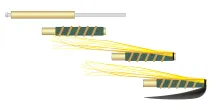
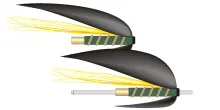
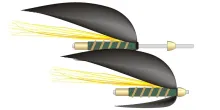
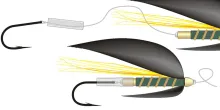
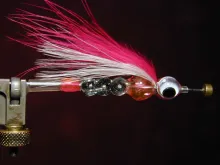
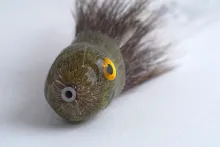
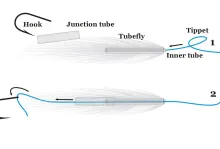






In my opinion and fr
In my opinion and from my experience fishing snakeheads back in Malaysia, Tube Flies should survive the ferocious teeth of the Giant Snakehead better than the normal flies. On one of the fishing trip I lost(damage due to the sharp teeth of the Giant Snakehead a.k.a. Toman, as it is called in Malaysia) dozens of flies.